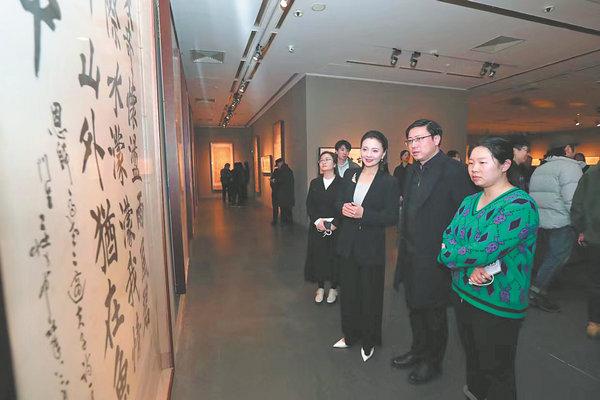Calligraphy exhibition pays tribute to 20th-century sage of integrity and virtue, Lin Qi reports.
A Comment on Lu Yanshao's Landscape Painting, a calligraphy work on a fan by Gao Ershi. [Photo provided to China Daily]
Wu Weishan, director of the National Art Museum of China, vividly remembers a trip to his ancestral home, Shiyan town in Dongtai, Jiangsu province, back in 1972. He saw Gao Ershi, a distant uncle of his father, and a calligrapher and scholar, walking alone on the street.
"He was dressed in a Zhongshan suit (Chinese tunic suit), and holding a stick while he walked," he recalls. "His scholarly charisma impressed me a lot. He looked so much like a man of wisdom and virtue from ancient times, like those portrayed in classic poems and paintings."
Wu says that, in his early teens, he often heard from his father about the amount of effort Gao had invested in calligraphy and the study of Chinese classics, and years afterward, he saw a lot of Gao's calligraphic works, which showed an integrated accumulation of literature and classic art.
"He was such an extraordinary man," Wu says.
Today, Gao is highly regarded as an outstanding scholar, poet and calligrapher of the 20th century. In his lifetime, he mostly lived in his native Jiangsu province, and his accomplishments were known largely among cultural circles. In recent years, however, his reputation has spread to the wider public, thanks to donated works and their display in art museums, inspiring research into his life and legacy.
A couplet by Gao. [Photo provided to China Daily]
One latest example is an exhibition of Gao's calligraphy at the Art Museum of Beijing Fine Art Academy. Running until Sunday, A Trace of Lanting brings together dozens of Gao's calligraphy works, as well as some by esteemed scholars and calligraphers in his close circle. There are also selected examples from the oeuvres of contemporary calligraphers in Jiangsu, which show Gao's long-standing influence.
The exhibition has been touring across China since it was initiated last year to mark the 120th anniversary of Gao's birth. It was first shown at Zhejiang Art Museum, in the provincial capital Hangzhou, and then Zhengzhou Museum of Art, in Henan province, which in total received some 200,000 visitors. It will travel back to Jiangsu — to Suzhou Art Museum — after the Beijing show.
Works on display are from the collections of public institutions and private collectors. It shows the enduring vigor of calligraphy as an important part of Chinese civilization, Wu says, linking the past and present. He adds that it also demonstrates the precious spiritual legacy Gao left to the world through his inheritance of various Chinese calligraphic scripts and efforts to reform the art and point out a direction for its future.
A calligraphy exhibition at the Art Museum of Beijing Fine Art Academy celebrates calligraphy master Gao. [Photo provided to China Daily]
Gao was particularly renowned for ushering caoshu, the cursive script, into a new realm through his own innovative approach. He is hailed in calligraphy circles as a "modern caoshu sage", partly owing to his mastery of the unique zhangcao style, a preliminary form of the cursive caoshu script, but blending the strokes of the clerical lishu script.
Wu Hongliang, director of Beijing Fine Art Academy, says Gao's calligraphy is grounded in his masterful command of the solemnity of zhangcao script, but, meanwhile, is imbued with the reckless temperament of the writings of father and son Wang Xizhi and Wang Xianzhi, the celebrated fourth-century calligraphers. Gao's long-term commitment to the studies of these ancient masters allowed him to create an even more artistic, highly expressive style of his own in the later stages of his life.
Gao is also respected for his rigorous approach toward academic study. A famed example is his avid involvement in an academic discussion in the 1960s pertaining to Lanting Xu (Preface to the Poems Composed at the Orchid Pavilion), a great piece by Wang Xizhi. Gao showed critical thinking, intensive learning and self-confidence, even when he had opposing views to experts in the field that were senior to him.
Gao fulfilled his commitment to carrying on the cultural lineage through cultivating a younger generation of scholar-calligraphers. He would invite students to his home, and give lectures on Chinese classic texts and art.
In 1987, an exhibition of Gao's work, in memory of the 10th anniversary of his passing, was held at Jiangsu Art Museum, in the provincial capital Nanjing, where Gao lived for decades. Lin Sanzhi, master calligrapher and a close friend of Gao, visited the show and, afterward, the 89-year-old wrote that," Gao lived up to the fulfillment of art, and led a life of distinction and integrity".
A calligraphy exhibition at the Art Museum of Beijing Fine Art Academy celebrates calligraphy master Gao. [Photo provided to China Daily]



